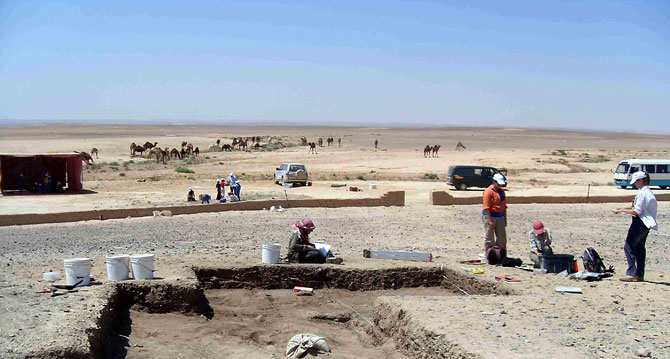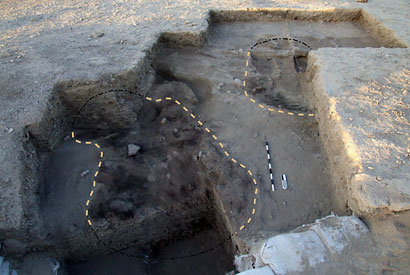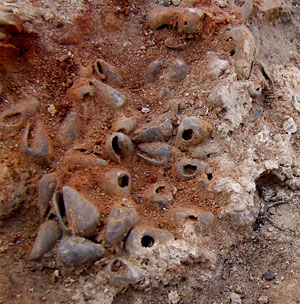Huts, artifacts in Jordanian excavation offer new perspectives on life 20,000 years ago

A joint team of American, British, Danish and Jordanian archaeologists working in eastern Jordan has announced its discovery of 20,000-year-old hut structures, the earliest yet found in that country. Along with materials found in the huts, the find suggests the area was once intensively occupied and offers a new perspective on how humans lived at the time.
The findings, published in the online edition of the journal PLoS One, describe huts used as residences, indicating behaviors – such as inhabitants’ growing attachment to their location and a far-reaching social network – that have been long linked to people living in cultures 10,000 years later.

Taken alongside the excavation in Israel of similar, slightly earlier huts that also reflect persistent site re-use by hunter-gatherers about 10,000 years before evidence of permanent farming village sites in the Neolithic period, the Jordanian find helps present a bigger picture of what people were doing then, and where, said Lisa A. Maher, UC Berkeley assistant professor of anthropology. She led the excavations at the approximately five-acre Kharaneh IV site in Jordan’s Azraq Basin and is co-author of the PLoS One report.
”Kharaneh IV is actually what we call an aggregation site – a place where large numbers of hunter-gatherer groups congregated for long periods of the year, probably for various purposes, including large-scale group hunting of local gazelle who also congregated here, and for social reasons, such as alliances, marriages, trade/exchange,” said Maher.
”So, sites like Kharaneh IV and Ohalo II in Israel tell us that the idea of a dramatic shift from small bands of Palaeolithic/Epipalaeolithic hunter-gatherers moving seasonally to larger farming villages in the Neolithic is not quite as dramatic as we once thought,” she said.
Even though the Kharaneh IV area today is starkly dry and barren, during the last Ice Age, the deserts of Jordan were in bloom, with rivers, streams and seasonal lakes and ponds that provided a rich environment for hunter-gatherers to settle in. The researchers have recovered hundreds of thousands of stone tools, animal bones and other materials from the site that now appears as little more than a high mound rising above the desert landscape.
“These huts are particularly interesting because they are so early and because of the fascinating and well-preserved artifacts found with them,” said Maher, noting the huts’ deliberately burnt piles of gazelle horn cores, clumps of red ochre pigment and a cache of hundreds of pierced marine shells. “The stone tools and animal bones vastly exceed the amounts recovered from most other sites of this time period in southwest Asia.”

In addition, the team also recovered rarer items, such as bones with regularly incised lines, a fragment of limestone with geometrically carved patterns, and shell beads. Many shells came from at least 200 kilometers away and some from the Indian Ocean, about 2,000 meters away.
”These shells were all intentionally pierced so that they could be strung – for example, worn as jewelry or sewn into clothing,” said Maher. ”Since these shells had to travel great distances to get to eastern Jordan, and they often convey economic or social/symbolic meaning, their presence at the site suggests that either people or just the shells were involved in extensive and long-distance travel or trade.”
The site of Kharaneh IV in the Jordanian desert shows there had been an enormous concentration of people in one place, said Jay Stock from the Department of Archaeology and Anthropology at the University of Cambridge and co-author of the PLoS One article.
“People lived here for considerable periods of time when these huts were built,” he said. “They exchanged objects with other groups in the region and even buried their dead at the site. These activities precede the settlements associated with the emergence of agriculture, which replaced hunting and gathering later on. At Kharaneh IV, we have been able to document similar behavior a full 10,000 years before agriculture appears on the scene.”
So far, the team has fully excavated two huts, and the researchers suspect there are more hidden beneath the desert’s sands.
Tobias Richter from the University of Copenhagen and a project co-director said the huts measure about 2-3 meters in maximum length and were dug into the ground, with walls and roofs of brush wood.
Kharaneh IV excavations are being carried out by the international, multi-disciplinary Epipalaeolithic Foragers in Azraq Project, a team with researchers based at UC Berkeley, the University of Cambridge, University of Copenhagen, University College London and University of Nottingham working closely with Jordan’s Department of Antiquities.
The researchers have spent three seasons excavating at the massive, 21,000-square-meter open-air site, one of the largest and densest Palaeolithic open-air sites in the region and the world. They will return in the fall, with funding from the Arts and Humanities Research Council UK, which has funded their previous work.
